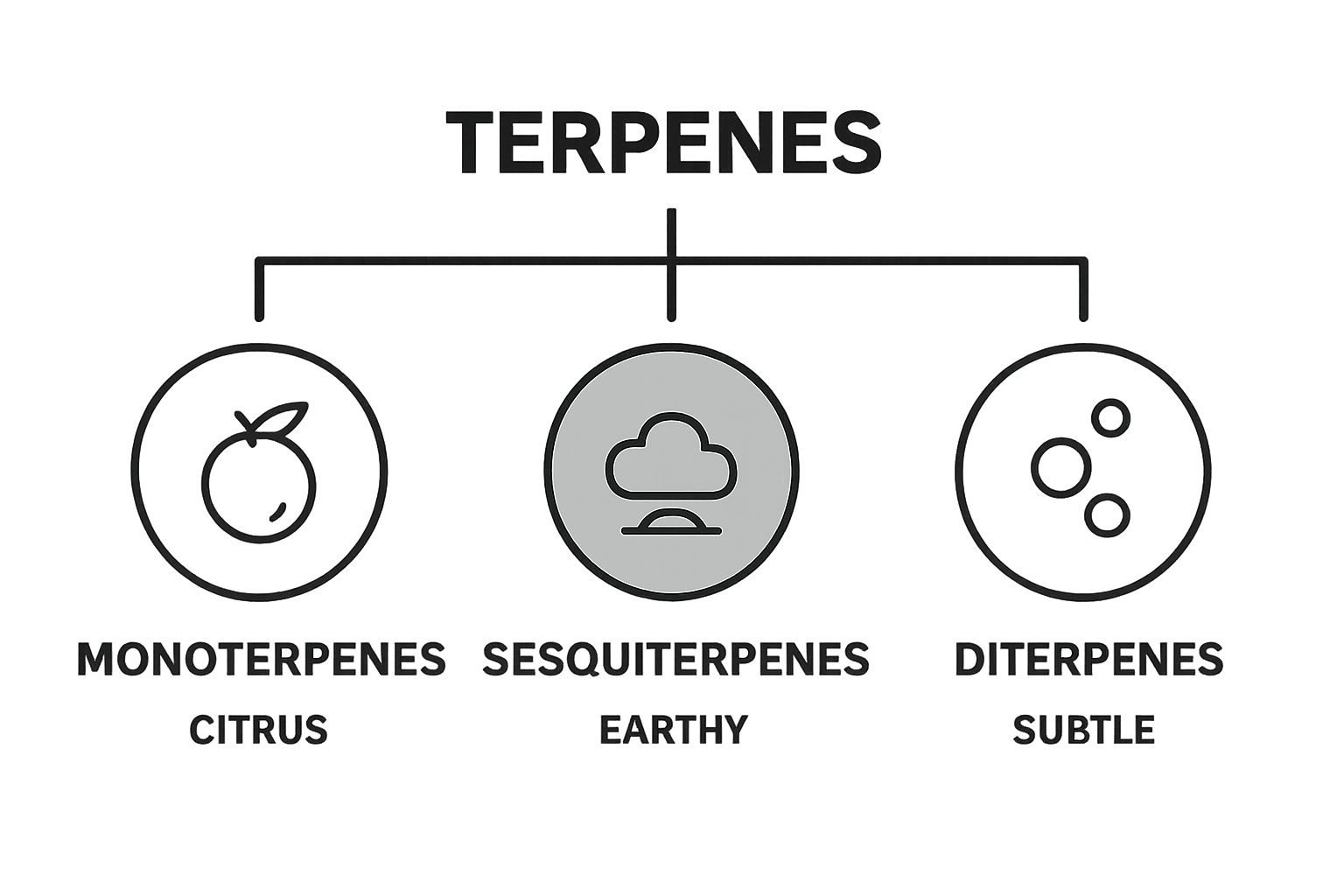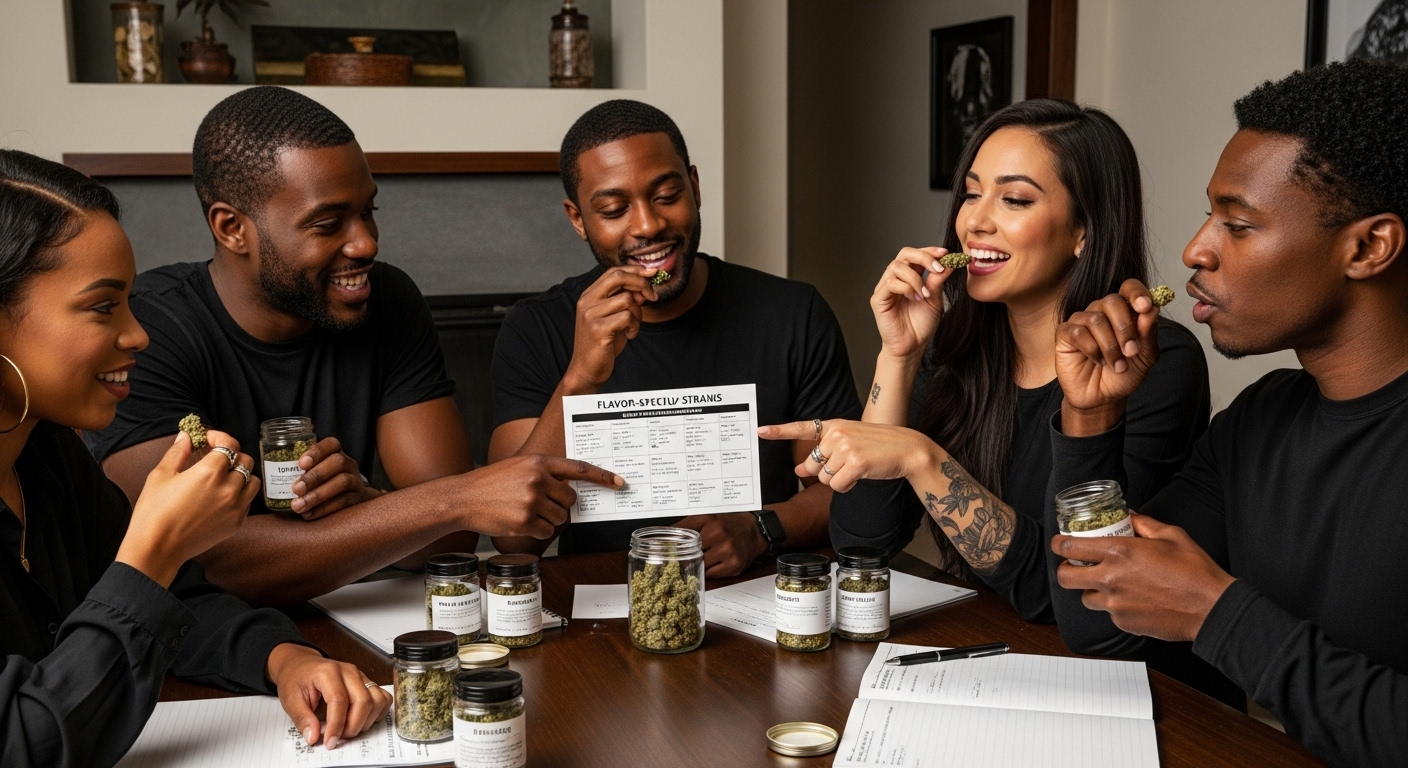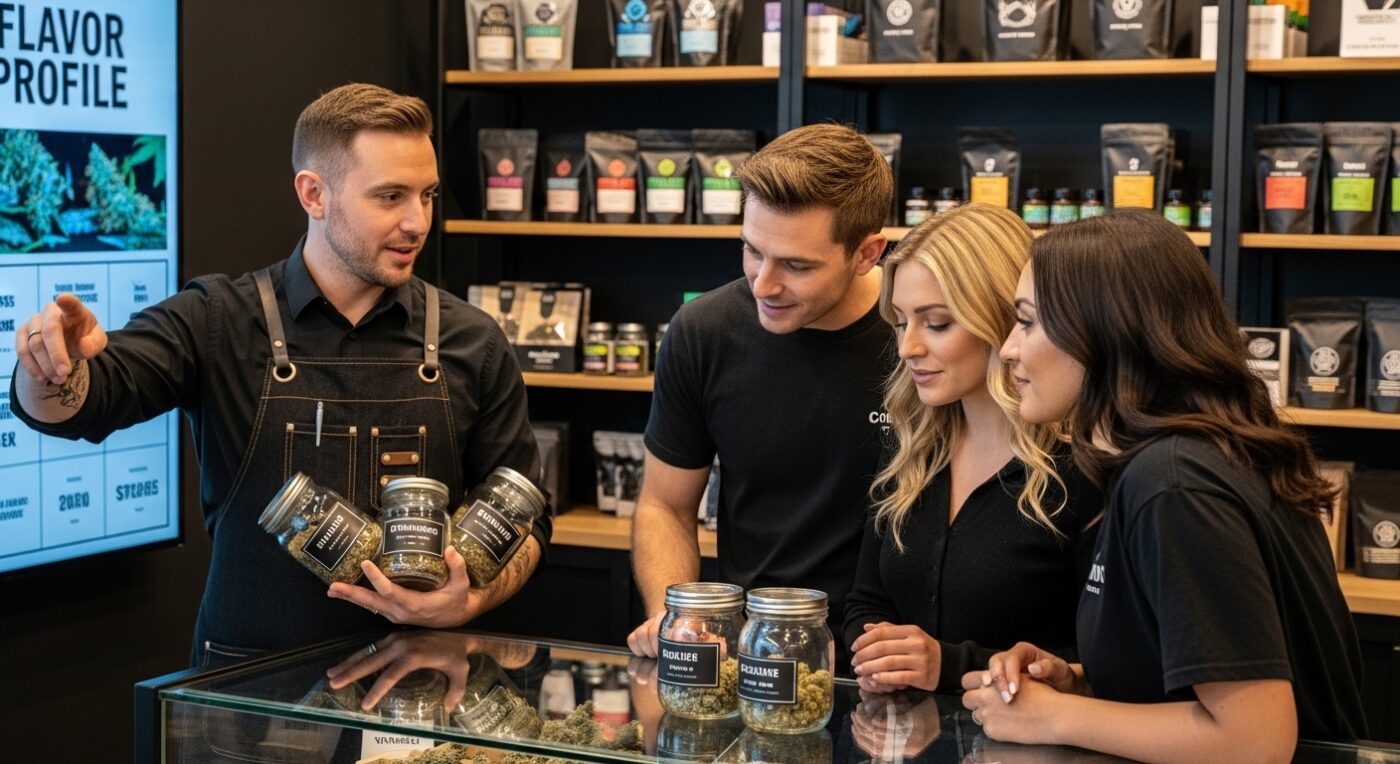Blog
Understanding the Role of Flavor Profile in Cannabis
Cannabis strains are often chosen for their flavors and aromas, but their complexity goes much deeper than taste alone. Research shows that there are hundreds of distinct chemical compounds in each strain, combining to create a sensory fingerprint that can even impact the effects on your mind and body. Most people just think picking a flavor is all about personal preference. The reality is these complex flavor profiles hold scientific clues that could make the difference between an energized afternoon or a laid-back evening.
Table of Contents
- What Is A Flavor Profile And Why It Matters?
- How Flavor Profiles Influence Consumer Experience
- The Science Behind Flavor Profiles In Cannabis
- Key Components Of Flavor Profiles: Terpenes And Beyond
- Real-World Applications: Choosing The Right Products
Quick Summary
| Takeaway | Explanation |
|---|---|
| Flavor profiles indicate potential effects. | Understanding flavor profiles aids in predicting the psychological and physiological responses to different cannabis strains. |
| Terpenes are key flavor contributors. | Terpenes are organic compounds that shape the scent and taste, influencing overall consumer experience significantly. |
| Identify strains by desired experience. | Consumers can select cannabis products that align with their wellness goals based on the strain’s flavor profile. |
| Professional guidance enhances selection. | Consulting experts helps consumers navigate complex flavor options and understand the relationship between aroma and effects. |
| Environmental factors shape flavor profiles. | Soil, climate, and cultivation techniques impact the chemical composition of cannabis, altering its flavor and effects. |
What is a Flavor Profile and Why It Matters?
In the cannabis world, a flavor profile represents the complex sensory experience created by the unique combination of chemical compounds within a specific strain. These compounds, primarily terpenes and flavonoids, generate distinctive aromas, tastes, and potential therapeutic interactions that go far beyond simple sensory pleasure.
The Chemical Symphony of Cannabis Flavors
A flavor profile is essentially a molecular blueprint of aromatic and flavor characteristics. Cannabis contains hundreds of compounds that contribute to its unique sensory signature. Terpene types play a crucial role in determining these profiles, with each strain presenting a distinctive aromatic fingerprint.
Key components of a cannabis flavor profile include:
- Terpenes: Organic compounds responsible for distinctive scents
- Flavonoids: Compounds contributing to color and potential therapeutic effects
- Cannabinoid interactions: Chemical interactions that modulate overall sensory experience
Why Flavor Profiles Matter to Consumers
Understanding flavor profiles helps consumers make more informed choices. According to research from the National Center for Biotechnology Information, flavor profiles are not just about taste—they provide insights into potential effects, quality, and even potential medicinal benefits.
Consumers use flavor profiles to:
- Predict potential psychological and physiological responses
- Select strains matching their desired experience
- Understand the complexity and quality of different cannabis varieties
Beyond personal preference, flavor profiles represent a sophisticated chemical interaction that transforms cannabis from a simple plant into a nuanced, personalized experience.
How Flavor Profiles Influence Consumer Experience
Flavor profiles represent more than just sensory pleasure in cannabis consumption—they are complex chemical interactions that profoundly shape user perception, expectations, and physiological responses. These intricate molecular signatures guide consumer choices and experiences in ways that extend far beyond simple taste preferences.
Psychological and Sensory Expectations
Consumers develop nuanced expectations based on flavor profiles. Understanding flavor-specific strains reveals how different aromatic characteristics can signal potential effects. A citrusy, bright profile might suggest an energetic experience, while earthy, musky notes could indicate a more relaxing interaction.
Key psychological influences include:
- Anticipatory sensory responses
- Emotional associations with specific aromas
- Contextual expectations based on previous experiences
Physiological Interactions and Effect Modulation
According to research from Frontiers in Psychology, flavor compounds do more than create pleasant sensations. Terpenes can actively modulate cannabinoid interactions, potentially influencing the overall physiological response. This means the flavor profile isn’t just about taste—it’s a critical factor in how cannabis affects an individual’s mental and physical state.
Significant physiological interactions include:
- Potential mood regulation
- Neurological response modifications
- Subtle changes in perceived intensity of effects
Understanding these complex interactions transforms flavor profiles from mere sensory experiences into sophisticated chemical communications that guide consumer choices and expectations.
The Science Behind Flavor Profiles in Cannabis
Cannabis flavor profiles are sophisticated molecular landscapes created through intricate biochemical processes within the plant. These complex chemical interactions determine not just taste and aroma, but potentially influence the overall physiological and psychological experience of cannabis consumption.
Biochemical Origins of Flavor Compounds
The foundation of cannabis flavor profiles lies in specialized plant molecules called terpenes and flavonoids. Understanding the role of flavor in vaping experience provides deeper insights into how these compounds interact. Terpenes are volatile organic compounds responsible for the plant’s distinctive scents, while flavonoids contribute to color and potential therapeutic characteristics.
Key biochemical components include:
- Monoterpenes: Responsible for citrusy and pine-like aromas
- Sesquiterpenes: Contributing to earthy and musky flavor notes
- Flavonoid phenolic compounds: Providing complex chemical interactions
Genetic and Environmental Influences
According to research from the National Institutes of Health, flavor profile development is a complex interplay between genetic predisposition and environmental conditions. Factors such as soil composition, climate, cultivation techniques, and plant genetics dramatically influence the final molecular composition of cannabis.
Significant genetic and environmental factors include:
- Specific strain DNA sequencing
- Cultivation altitude and temperature
- Soil nutrient composition
- Harvest and curing methods
These scientific nuances transform cannabis from a simple plant into a sophisticated chemical system, where every molecular interaction contributes to its unique sensory and experiential signature.
Key Components of Flavor Profiles: Terpenes and Beyond
Cannabis flavor profiles are intricate molecular networks composed of multiple chemical compounds that interact to create complex sensory experiences. While terpenes often receive primary attention, the complete flavor landscape involves a sophisticated interplay of diverse molecular structures.
Terpenes: The Primary Flavor Architects
Terpenes are organic hydrocarbons that serve as the primary architects of cannabis flavor profiles. Learn more about terpene types to understand their diverse characteristics. These volatile compounds generate distinctive aromas and contribute significantly to the plant’s sensory complexity.
Key terpene categories include:

- Monoterpenes: Producing light, fresh aromas
- Sesquiterpenes: Creating deeper, more complex scent profiles
- Diterpenes: Contributing to subtle flavor nuances
Beyond Terpenes: A Molecular Diversity
According to research from ACS Omega, flavor profiles extend beyond terpenes. Nonterpenoid compounds like volatile sulfur compounds and flavonoids play crucial roles in developing intricate aromatic characteristics.
Additional flavor-contributing compounds include:
- Flavonoids: Providing color and potential therapeutic properties
- Phenolic compounds: Adding depth to flavor complexity
- Volatile sulfur compounds: Creating unique aromatic signatures
These molecular interactions transform cannabis from a simple botanical specimen into a sophisticated sensory experience, where each compound contributes to a nuanced and dynamic flavor profile.
The following table summarizes the key chemical components found in cannabis flavor profiles, highlighting their role and contribution to the overall sensory experience.
| Component | Description | Main Contribution |
|---|---|---|
| Terpenes | Organic compounds responsible for aroma and scent | Distinct aromas, impact on flavor and effects |
| Flavonoids | Compounds contributing to color and potential therapeutic effects | Color, subtle taste, possible health benefits |
| Monoterpenes | Subtype of terpenes, smaller molecules | Citrusy, pine-like aromas |
| Sesquiterpenes | Subtype of terpenes, larger molecules | Earthy and musky notes |
| Phenolic Compounds | Organic molecules with aromatic ring structures | Depth and complexity of flavor |
| Volatile Sulfur Compounds | Molecules containing sulfur, highly aromatic | Unique pungent aromas, distinctive signatures |
Real-World Applications: Choosing the Right Products
Selecting cannabis products involves more than casual preference—it requires understanding how flavor profiles translate into specific experiences and desired outcomes. Consumers now approach cannabis selection with a sophisticated scientific lens, analyzing molecular compositions to match their individual needs and expectations.
Matching Flavor Profiles to Desired Effects
Flavor profiles serve as sophisticated molecular indicators of potential cannabis experiences. Explore flavor-specific strains to comprehend how different aromatic signatures correlate with anticipated physiological and psychological responses. Citrusy profiles, for instance, often suggest energetic, uplifting experiences, while earthy, musky notes might indicate more relaxing interactions.
Key considerations for product selection include:
- Identifying personal wellness goals
- Understanding individual physiological responses
- Recognizing aromatic indicators of potential effects
The table below compares how different types of cannabis flavor profiles can suggest potential effects and match consumer expectations.
| Flavor Profile | Common Aromas | Suggested Effects | Typical Consumer Expectations |
|---|---|---|---|
| Citrusy | Lemon, orange, lime | Energizing, uplifting | Focus, creativity, daytime use |
| Earthy/Musky | Wood, pine, musk | Relaxing, calming | Stress relief, evening use |
| Sweet/Berry | Berries, candy | Balanced, euphoric | Mood boost, pleasant socialization |
| Spicy/Herbal | Pepper, mint, herbs | Alert, clear-headed | Clarity, enhanced mental focus |
| Floral | Lavender, rose | Mellow, soothing | Relaxation, mild mood elevation |
Professional Guidance and Consumer Education
According to research published in the Journal of Cannabis Research, professional guidance plays a crucial role in helping consumers navigate complex flavor profile selections. Trained professionals can assist in decoding the intricate relationships between aromatic compounds and anticipated cannabis experiences.
Important selection strategies involve:
- Consulting cannabis sommeliers
- Reviewing detailed chemical analysis reports
- Understanding personal sensitivities and preferences
By approaching cannabis selection as a nuanced, scientifically informed process, consumers can transform their experience from random consumption to intentional, personalized molecular interaction.

Discover Flavor Profiles That Elevate Your Experience With Puff Laco
Craving cannabis products that deliver more than just a simple high? If you have ever struggled to predict the real effects or quality behind bold flavor claims, you are not alone. This article shows that understanding a cannabis flavor profile is essential for matching your needs, mood, and unique taste. Puff Laco takes the guesswork out by offering clearly labeled products that highlight precise terpene blends, strain genetics, and verified flavor-specific strains, so you can confidently select exactly what suits you best. Our strict testing procedures guarantee the purity and authenticity discussed in the article, meaning you always get what you expect from every vape, edible, or pre-roll.
.png)
Stop settling for mystery cannabis. Instead, try expertly crafted premium cannabis products that truly reflect the science and nuance of flavor profiles, from uplifting live resins to relaxing gummies and everything in between. Visit Puff Laco now for a seamless shopping experience, fast shipping, and exclusive deals. The right flavor can transform your session. Start choosing with confidence today.
Frequently Asked Questions
What is a flavor profile in cannabis?
A flavor profile in cannabis refers to the unique combination of chemical compounds, primarily terpenes and flavonoids, that generate distinctive aromas, tastes, and potential therapeutic effects within a specific strain.
How do flavor profiles affect the cannabis user experience?
Flavor profiles influence user expectations and physiological responses. Different aromas can signal potential effects, such as energizing or relaxing experiences, based on the chemical interactions present in each strain.
What are terpenes and how do they contribute to cannabis flavor profiles?
Terpenes are organic compounds responsible for the distinct scents in cannabis. They play a significant role in shaping flavor profiles by creating various aromatic characteristics that can signal potential effects.
How can consumers use flavor profiles when selecting cannabis strains?
Consumers can use flavor profiles to predict psychological and physiological responses when selecting cannabis strains. By understanding the aromatic signatures, they can choose strains that align with their desired experiences and wellness goals.
Recommended
- Understanding What Are Flavor-Specific Strains
- Understanding the Role of Flavor in Vaping Experience
- 7 Terpene Types Explained
- Understanding the Role of Strain Selection in Cannabis

